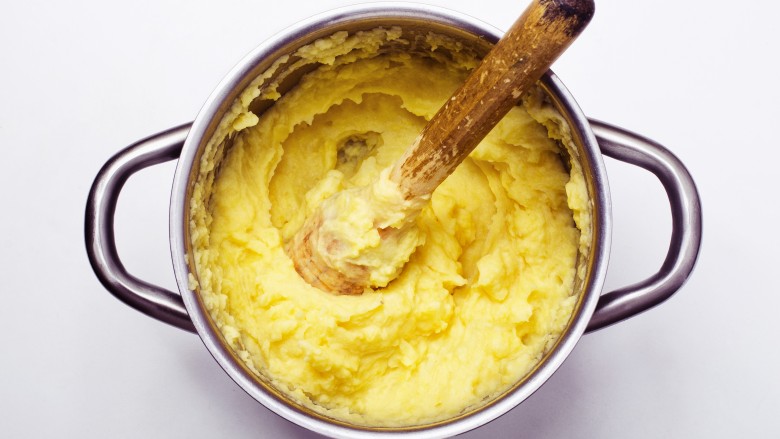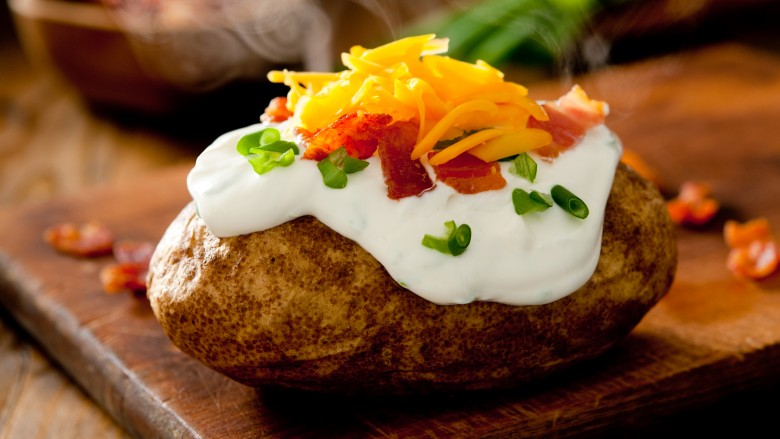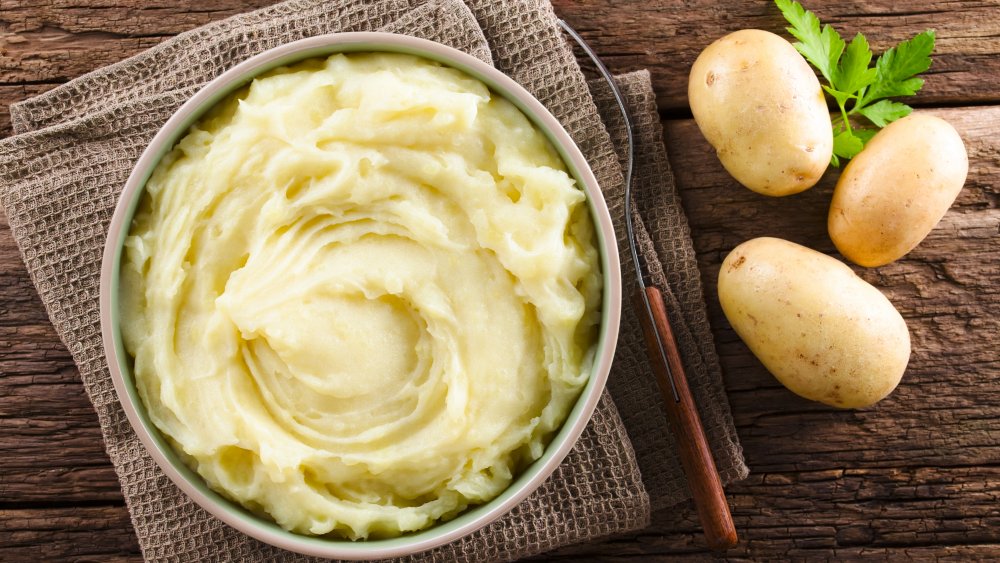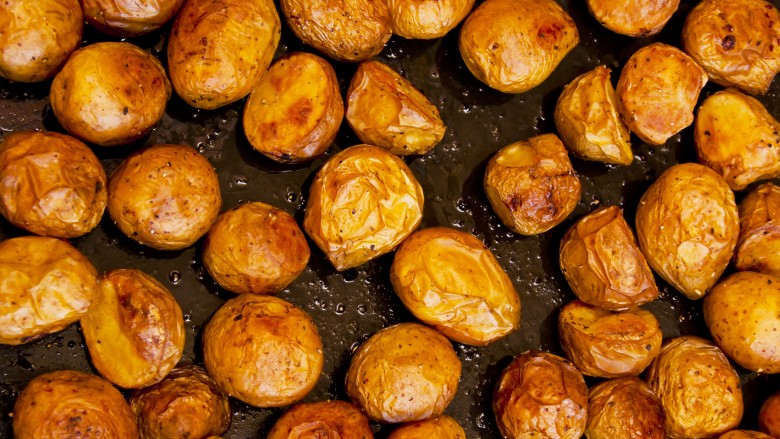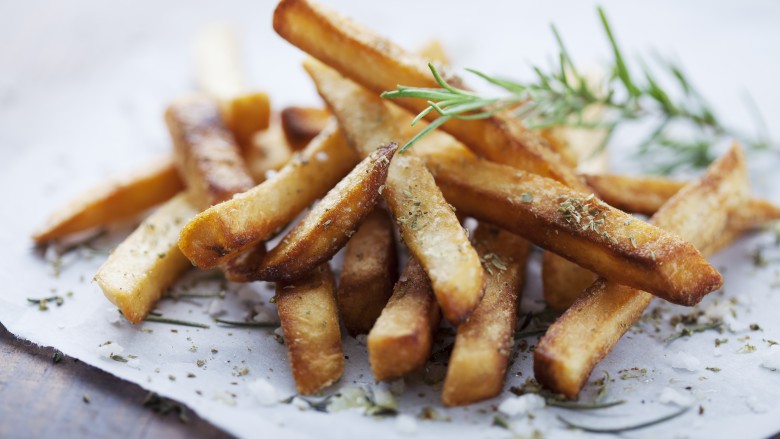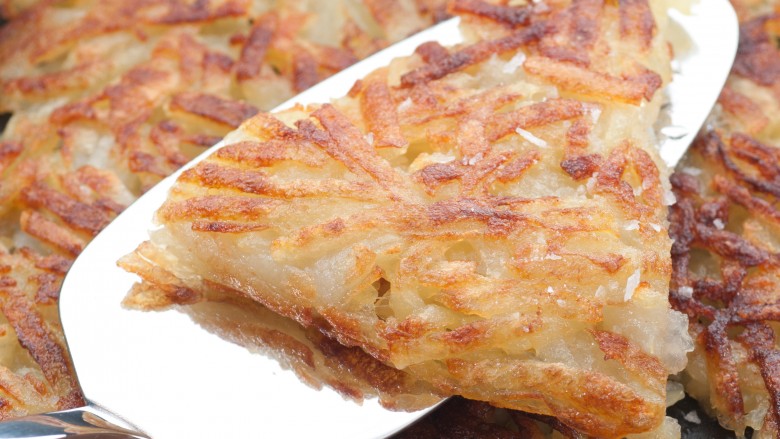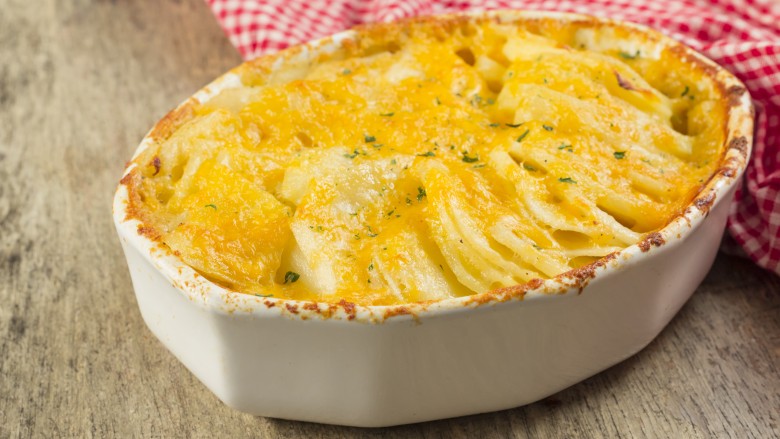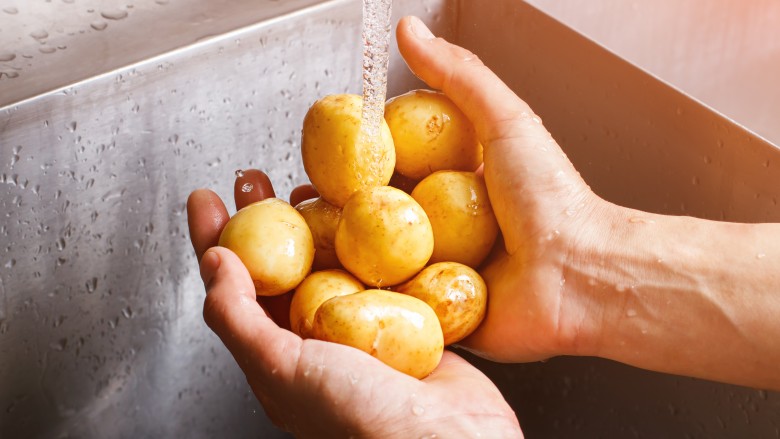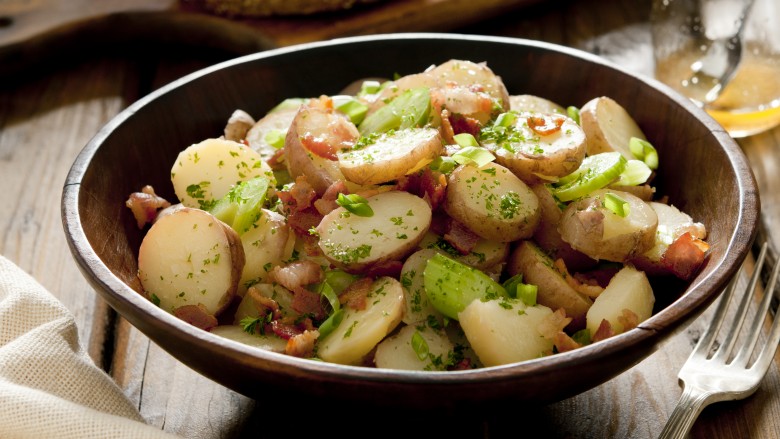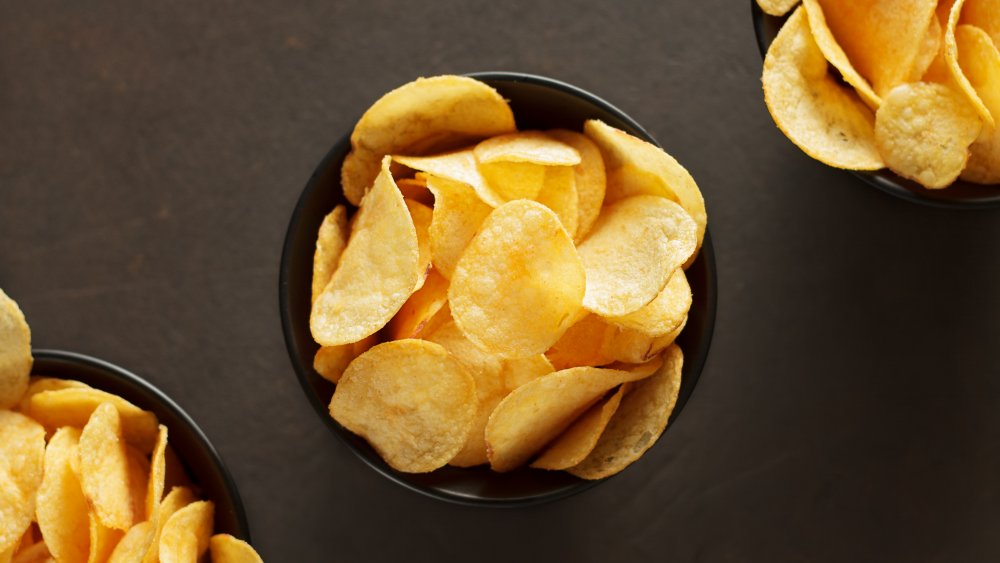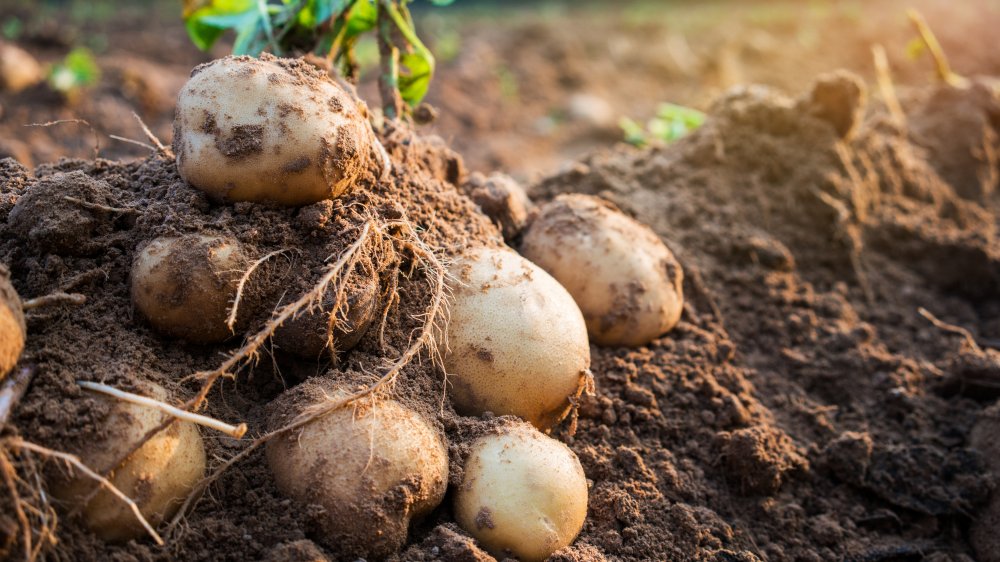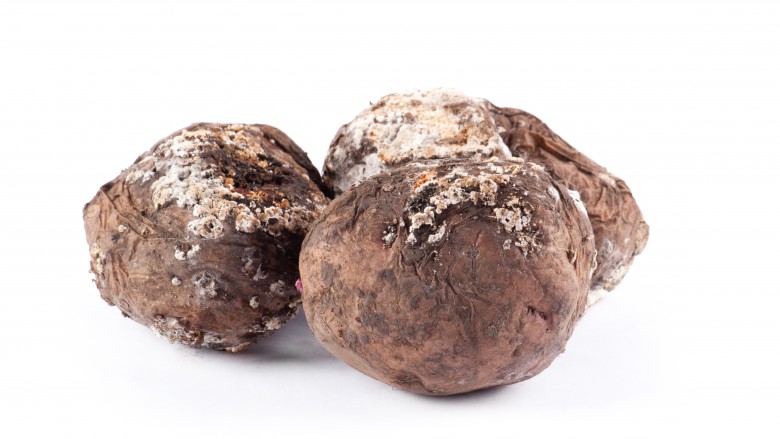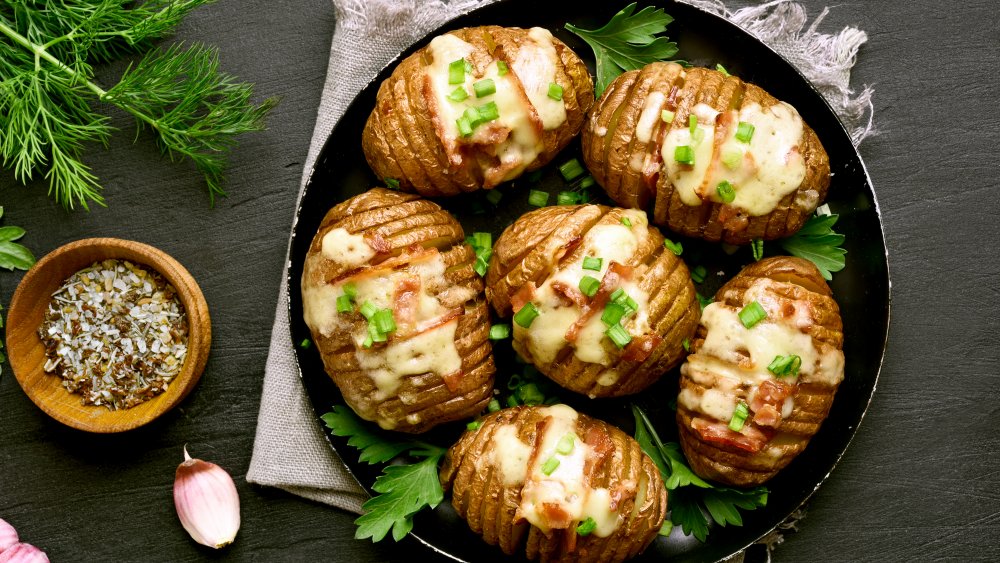Mistakes Everyone Makes When Cooking Potatoes
You'd be hard-pressed to find a gal who loves potatoes more than we do. Deserted island food? If we also had some salt...possibly. Amazingly versatile, and fantastic as a rustic entree or a gussied up side dish... what's not to love about potatoes?
Potatoes come in a zillion varieties, but they fall into three basic categories. First, you have your starchy variety. The one you are familiar with due to its availability at the market is the russet, often referred to as an Idaho potato, or baking potato. The next category are your waxy potatoes, sometimes referred to as boiling potatoes. These are your full-sized round red and white, thin-skinned potatoes. The next category is the all-purpose potato, with the most common one being the Yukon gold. It's starchy, but not so much as a russet.
The key to mastering the art of the potato lies in knowing which potato is the ideal variety for the cooking task at hand.
Gluey mashed potatoes
Let's get started with one of the most luscious ways to prepare the humble potato — mashed potatoes. Mashed potatoes are likely where you're making your most grievous errors. First, a starchy variety is going to produce the fluffy consistency you're after, so go for a russet or even a richly-flavored all-purpose variety like a Yukon. Start your potatoes in a pot of cold water, and then crank up the heat. Once the water begins to boil, you want to salt it up well, or else your potatoes will taste woefully under-seasoned.
Once the potatoes can be pierced through easily, drain off the water, return them to their hot pan, and begin to add your other ingredients — which you should heat in a separate pan before adding. Gently mash or whisk the potatoes until they're just where you want them — but don't overwork them, or you'll get a gluey, unappetizing texture.
One more rule: Don't use a food processor — it will overwork your potatoes. A regular masher or whisk is all you need, though they'll be terrifically smooth if you process the cooked spuds with a ricer or food mill. For super creamy mashed potatoes, try mixing them using the whisk attachment of your stand mixer. I do this every Thanksgiving with loads of heavy cream and butter, and they are deliciously decadent.
Chewy baked potatoes
Since you're aiming for a fluffy interior, the same varieties of potato that work so beautifully for mashed potatoes are also going to translate well to a baked potato. Russets are the common choice — they provide the oval shape and hefty size most people think of when they want to get their baked potato on. Wash your potato well, and dry it off as best you can. If you're cooking a wet potato, you're going to steam the skin, when what you really want to do is crisp it. I find it's best to wash my potatoes a good 15 minutes before cooking them.
Pierce them a few times with a fork (yes, it is possible for an unpierced potato to burst,) and rub them lightly with oil. I also like to give the oiled potatoes a rub of kosher salt. If I'm cooking them on my outdoor grill, which gets searingly hot, I wrap them tightly with tin foil. When using my oven, I place them directly on the middle rack at 425 degrees Fahrenheit. They should be perfect after an hour, but large ones may need 10 minutes more. Pierce with a fork to check for doneness — the fork should go in easily and you should be able to detect the light crispiness of the skin. Let the potatoes rest for a few minutes before you handle them, or you may scald yourself when you cut them open. Just before serving, slice them open, gently mash the interior with a fork, and top accordingly.
Watery mashed potatoes
Mashed potatoes are a balancing act — you don't want to get them too dry, and watery mashed potatoes are definitely no better. If they're dry, you already know they're easy to fix. But what if they're too wet? If you're just resigning yourself to doing better next time, you should know there's a super simple way to salvage your side dish — regardless of whether that watery texture came from slipping and adding too much milk, or accidentally overcooking your potatoes.
AllRecipes says that all you need is a cheese grater and another potato... or few. Just grate a few potatoes, then put them in a shallow pan, add water, and bring them to a boil — but just very, very quickly. Drain, add a dash of salt and pepper, and mash them a little bit further. That's it! Don't add anything else to them before adding them to your already watery mashed potatoes, and it'll thicken them up nicely. There's no need to suffer through watery mashed potatoes ever again!
And, there's a bonus! You might end up with more than you intended, but that's a good thing — there are a ton of delicious things you can make with those leftover mashed potatoes.
Soggy roasted potatoes
The biggest mistake most folks make when trying to roast potatoes is cutting the potatoes into chunks, dousing them in oil, and tossing them in the oven. The resulting roasted potato will be burnt on the outside, and not fully cooked on the inside.
For the crunchy yet soft roasted potato you desire, you must parcook the potato chunks in boiling water before roasting. Drain the partially cooked potatoes, then add them back to the pot, and give them a really good shake around. You want to mush them up so the outside gets a fluffy, chuffed appearance — that's the part that's going to crisp. Toss them in plenty of fat — oil will do, animal fat or drippings is even better — and add them to your roasting pan. Salt them liberally, and place the pan in a hot 450-degree oven. The rate at which they cook will depend on the variety and age of the potato, so you do need to keep an eye on them to determine doneness. They'll need to be turned at some point, maybe 20 minutes in, and you may need to coax them with a spatula (I use my fish spatula, which is thin enough to pry up the potatoes without breaking them). My favorite roasted potatoes are the ones I make in the same pan as my roast chicken. I cook the chicken for about 20 minutes while the potatoes boil, and then carefully add and stir them into the hot chicken fat in my roasting pan. Drool.
Limp french fries
You really do want starchiness when making French fries, so once again, a russet will do nicely. You do, however want to soak out a bit of the starch, and you do this by placing your evenly cut potato slices in cold water. Let them soak for 30 minutes, rinse, and repeat with smaller soaking times once or twice. This step is important, because it will prevent your fries from browning as you cook them. Dry the potatoes as well as you can, preferably leaving them to dry on a rack or kitchen towel.
Now you need to heat up an oil with a high smoke point — olive oil or butter is not going to do. Popular choices include canola or peanut oil, and I have done well using neutral-flavored grape-seed oil. Ideally, you'll use a deep fry thermometer, and heat your oil in a deep, sturdy vessel, like a dutch oven. You are actually going to fry your fries twice — once at about 330 degrees for a few minutes, until they just soften. Remove the potatoes to a baking sheet lined with a kitchen towel, raise the heat to 360 degrees, and fry the potatoes again until they're crisp. Remove to the baking sheet, salt liberally, and serve immediately.
Not crispy hash browns
A shredded russet is going to work best here, you can use a box grater or the shredding attachment of a food processor. Soak the shredded potatoes in cold water, just like you would do for fries, and drain out the excess liquid as much as you can. The ideal pan for hash browns is a cast iron pan. Heat it with a good amount of fat like bacon grease, butter, or cooking oil, and add your shredded potatoes in an even layer. The biggest mistake you can make at this point is to keep moving the potato shreds all around the pan. Fight that temptation, and leave them be for a solid 5 or 10 minutes while they caramelize in the pan. Season the potatoes well, and flip them over in sections, and repeat on the other side, though the other side will cook a bit faster. Flip and repeat until they are your desired crispiness.
Watery scalloped potatoes
Some people swear by a waxy potato for casseroles, as it will retain its shape, but I believe you want starchiness for a scalloped potato. Plan to once again grab your long whites, russets or all-purpose Yukon golds (I promise you I will get to situations when you want waxier potatoes.) The mistake most people make with a scalloped or gratin potato is trying to make it without plenty of fat. If you use low-fat or even regular milk to make your sauce, you'll end up with a watery casserole. Best to use heavy cream in your recipe.
The next mistake people make is not cutting the potatoes thinly enough. Use a mandoline if you have one. If not, slice the peeled potatoes as close to an eighth of an inch thick as you can. Simmer with plenty of cream, and don't forget to season. Then, layer the potato slices in a casserole dish, adding cheese if you are using it (a true scalloped potato would be cheese-free, and a classic French gratin dauphinoise would just have a fine layer on top.) The combination of cream and starch are going to make a fantastic thickened sauce, and you will be able to slice the casserole into squares, rather than spoon it out. If you like the shape of scalloped potatoes, but prefer a lighter variation, try making a potato boulangere, using herbs and stock instead of cream.
Disintegrated potato soups and stews
At last! A reason to embrace a red potato! Actually, a waxy potato in any color or size is going to be the ideal potato for a soup, IF you want the potato to hold its shape. If you are looking to make a thickened potato-based soup, the starchier varieties are still going to achieve that for you. But, if you are looking to make a vegetable soup or a stew with lovely chunks of potato that don't completely dissolve as you slow cook it, that's when waxy potatoes are your BFF. A common mistake many people make when using potatoes in soup, however, is to add them way too early. If you're slow-cooking a soup or stew for hours, hold off until the last hour or so of cook-time to achieve tender morsels that don't unappealingly disintegrate into potato mush.
Mushy potato salad
Yet another example of embracing a waxy potato! The biggest crime in the world of potato salad is when folks mistakenly attempt to create it using a starchy variety of potato. Remember, they are called boiling potatoes for a reason! Any waxy potato, or even better, a combination of waxy potatoes, is going to make the perfect potato salad. The next mistake people make is overcooking the potatoes, which should really only be cooked until they are just fork tender, and neglecting to liberally salt the cooking water, which is really your only opportunity to adequately season your spuds.
The last mistake? Dressing the potatoes at the wrong time. For a mayo-based dressing, add the dressing a half hour or so before serving, but only once the potatoes are room temperature or chilled. For a vinaigrette-based dressing, add it to the warm potatoes so they soak up all that flavor.
Hard homemade potato chips
Making homemade potato chips is definitely fun, and it lets you experiment with all kinds of crazy flavors you're just not going to find in the grocery store. But it can be challenging, and one of the biggest problems are chips that come out so hard that you'll have to wonder if you're risking a broken tooth. On the other hand, it's entirely possible you'll get a batch without that pleasant crunch, so what gives?
The Guardian describes getting the perfect potato chip as "a slippery slope," and it totally is. They say that the most common mistake is not cutting the potatoes to the proper thickness, and there's a bit of debate on just what that is. Some — like Martha Stewart — recommend going with ⅛ inch thickness, or 6mm. Others suggest 3mm — but if you're outside that range, you're going to have problems. Cut them too thick and they won't get crispy, and too thin, and they'll shatter when you bite them.
They also add that another common mistake is not rinsing the potatoes: you'll want to get rid of much of the starch. And as tempting as it might be to bake them, they say that's not the way to get a truly delicious chip... even though you might want something that's a little healthier. If you want a real chip — a chip that's as delicious as the grocery store versions — you'll need to fry them. Sorry, there's no way around it!
Washing potatoes wrong
Whether you're making mashed potatoes or roast potatoes, french fries or baked potatoes, it's entirely possible you're sabotaging your dish right from the beginning.
According to the Idaho Potato Commission, there's a specific way you should be washing your potatoes — and yes, they say, you should be washing them. While they're typically cleaned at the shipping facility, that usually doesn't get all the dirt out. So, that means you should be giving them a good scrubbing.
They add that there's no need for soap or any other washes, just some good, old-fashioned elbow grease. (That means "use your muscles," for anyone who hasn't heard that term!) The job can be made quite a bit easier if you soak them for a few minutes first, then scrub.
But, there's a few common practices you shouldn't be doing. Don't wash them too far in advance of using them, or they might start to get moldy in storage. And don't use that old trick of running them through the rinse cycle of your dishwasher, as it's likely they're still being exposed to soap residue.
Finally, be sure to dry them. Fine Cooking notes that residual water interferes with the cooking process, so if you want those nice, crispy fries, make sure your taters are dry.
Rotten potatoes?
The biggest potato mistake in history? Eating potatoes that are so old, they kill you. All potatoes are members of the nightshade variety of plants, which contain a compound called solanine. Our bodies can dispose of solanine easily enough in normal concentrations, but when a potato has been stored too long, or stored improperly, the compound can build up to amounts that can make us very ill, and can even be fatal. Potatoes with visibly green chlorophyll on or under the skin is a sure sign of elevated solanine levels, so best to toss those spuds. Cutting off the potato's sprouts, or "eyes", is also advised, as the sprouts themselves do contain some of the nasty stuff. Potatoes can also change flavor as they are stored, so shriveled potatoes should be tossed as well. Potatoes should always be stored when dry, as to prevent mold, so wait to wash your potatoes until you are ready to use them.
The best way to store potatoes is in a cool, dark environment, in the 45-55 degrees Fahrenheit range. Some folks are fans of storing potatoes in the fridge, where they can last for months. Fridge storage can change a potato's flavor and color, making it sweeter and darker, but this flavor change can be rectified by simply allowing the potato to return to room temperature for a few days before cooking it.
Dangerous baked potatoes
Quick, how do you make baked potatoes? You wrap them in foil and bake them, right? It turns out, that's not the best thing to do for a pretty serious reason.
First, when you bake your potato in foil, you're trapping the moisture inside — and that's making your baked potato soggy, according to the experts over at Idaho Potato. Yuck, right? You also can't see how your potato's coming along, and that makes it easy to overcook or undercook it.
But there's something dangerous at work here, too. State Food Safety warns that if you have any leftover potato — or, let's say you made an extra for lunch the following day — you might just pop the whole thing in the fridge. But if it's wrapped in foil, it's going to be a breeding ground for botulism and that, of course, can make you very, very sick.
So, what should you be doing? The Kitchn says you can just skip the foil, poke the skin a few times with a fork, and bake them right on an oven rack or baking sheet. Set the oven to 425, and flip them about even 20 minutes during the hour-long baking time. That's it!

